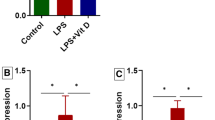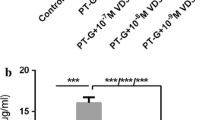Abstract
Lipopolysaccharide was found to be elevated in the plasma of necrotizing enterocolitis (NEC) and inflammatory bowel disease (IBD) patients and may play an important role in the pathogenesis and propagation of these intestinal diseases. To illustrate the destructive effect of lipopolysaccharide (LPS) and to test the protective effect of 1,25-Dihydroxyvitamin D3 (1,25(OH)2D3) on LPS-induced barrier injury, an in vitro intestinal epithelia barrier model was established with Caco-2 monolayers and treated with clinically relevant concentrations (1–10 ng/ml) of LPS with or without 1,25(OH)2D3. Transepithelial electrical resistance (TEER) and FITC-Dextran 40kda (FD-40) flux were measured to reflect monolayer permeability. We found that LPS at clinically relevant concentrations increased intestinal permeability by downregulating and redistributing tight junction (TJ) proteins. 1,25(OH)2D3 added at baseline or at day 4 abrogated the destructive effect of LPS on monolayer permeability by restoring the expression and localization of TJ proteins. LPS, at clinically relevant concentrations, also downregulated the expression of vitamin D receptor (VDR); 1,25 (OH)2D3, however, could restore the expression of VDR. Our findings illustrate the mechanism underlying the destructive effect of clinically relevant concentrations of LPS on intestinal TJ barrier and provide evidence for the clinical application of vitamin D in LPS-related intestinal barrier dysfunction.






Similar content being viewed by others
References
Turner, J.R. 2009. Intestinal mucosal barrier function in health and disease. Nature Reviews Immunology 9(11): 799–809.
Clark, J.A., S.M. Doelle, M.D. Halpern, T.A. Saunders, H. Holubec, K. Dvorak, S.A. Boitano, and B. Dvorak. 2006. Intestinal barrier failure during experimental necrotizing enterocolitis: protective effect of EGF treatment. American Journal of Physiology. Gastrointestinal and Liver Physiology 291(5): G938–G949.
Arrieta, M.C., K. Madsen, J. Doyle, and J. Meddings. 2009. Reducing small intestinal permeability attenuates colitis in the IL10 gene-deficient mouse. Gut 58(1): 41–48.
Berman, L., and R.L. Moss. 2011. Necrotizing enterocolitis: an update. Seminars in Fetal and Neonatal Medicine 16(3): 145–150.
Mennigen, R., K. Nolte, E. Rijcken, M. Utech, B. Loeffler, N. Senninger, and M. Bruewer. 2009. Probiotic mixture VSL#3 protects the epithelial barrier by maintaining tight junction protein expression and preventing apoptosis in a murine model of colitis. American Journal of Physiology. Gastrointestinal and Liver Physiology 296(5): G1140–G1149.
Ammori, B.J., P.C. Leeder, R.F. King, G.R. Barclay, I.G. Martin, M. Larvin, and M.J. McMahon. 1999. Early increase in intestinal permeability in patients with severe acute pancreatitis: correlation with endotoxemia, organ failure, and mortality. Journal of gastrointestinal surgery: official journal of the Society for Surgery of the Alimentary Tract 3(3): 252–262.
Marshall, J.C., P.M. Walker, D.M. Foster, D. Harris, M. Ribeiro, J. Paice, A.D. Romaschin, and A.N. Derzko. 2002. Measurement of endotoxin activity in critically ill patients using whole blood neutrophil dependent chemiluminescence. Critical Care (London, England) 6(4): 342–348.
Guo, S., R. Al-Sadi, H.M. Said, and T.Y. Ma. 2013. Lipopolysaccharide causes an increase in intestinal tight junction permeability in vitro and in vivo by inducing enterocyte membrane expression and localization of TLR-4 and CD14. The American Journal of Pathology 182(2): 385–388.
Kong, J., Z. Zhang, M.W. Musch, G. Ning, J. Sun, J. Hart, M. Bissonnette, and Y.C. Li. 2008. Novel role of the vitamin D receptor in maintaining the integrity of the intestinal mucosal barrier. American Journal of Physiology. Gastrointestinal and Liver Physiology 294(1): G208–G216.
Liu, W., Y. Chen, M.A. Golan, M.L. Annunziata, J. Du, U. Dougherty, J. Kong, M. Musch, Y. Huang, J. Pekow, C. Zheng, M. Bissonnette, S.B. Hanauer, and Y.C. Li. 2013. Intestinal epithelial vitamin D receptor signaling inhibits experimental colitis. The Journal of Clinical Investigation 123(9): 3983–3996.
Zhao, H., H. Zhang, H. Wu, H. Li, L. Liu, J. Guo, C. Li, D.Q. Shih, and X. Zhang. 2012. Protective role of 1,25(OH)2 vitamin D3 in the mucosal injury and epithelial barrier disruption in DSS-induced acute colitis in mice. BMC Gastroenterology 12: 58.
Ye, D., S. Guo, R. Al-Sadi, and T.Y. Ma. 2011. MicroRNA regulation of intestinal epithelial tight junction permeability. Gastroenterology 141(4): 1323–1333.
Xu, L.F., X. Teng, J. Guo, and M. Sun. 2012. Protective effect of intestinal trefoil factor on injury of intestinal epithelial tight junction induced by platelet activating factor. Inflammation 35(1): 308–315.
Puthia, M.K., S.W. Sio, J. Lu, and K.S. Tan. 2006. Blastocystis ratti induces contact-independent apoptosis, F-actin rearrangement, and barrier function disruption in IEC-6 cells. Infection and Immunity 74(7): 4114–4123.
Ma, T.Y., N. Hoa, D. Tran, V. Bui, A. Pedram, S. Mills, and M. Merryfield. 2000. Cytochalasin B modulation of Caco-2 tight junction barrier: role of myosin light chain kinase. American Journal of Physiology. Gastrointestinal and Liver Physiology 279(5): G875–G885.
Ma, T.Y., D. Nguyen, V. Bui, H. Nguyen, and N. Hoa. 1999. Ethanol modulation of intestinal epithelial tight junction barrier. American Journal of Physiology. Gastrointestinal and Liver Physiology 276(4 Pt 1): G965–G974.
Qiu, B., G. Zhao, Y. Aoki, L. Shi, A. Uyei, S. Nazarian, J.C. Ng, and P.N. Kao. 1999. Immunosuppressant PG490 (triptolide) inhibits T-cell interleukin-2 expression at the level of purine-box/nuclear factor of activated T-cells and NF-kappaB transcriptional activation. The Journal of Biological Chemistry 274(19): 13443–13450.
Schlegel, N., M. Meir, V. Spindler, C.T. Germer, and J. Waschke. 2011. Differential role of RhoGTPases in intestinal epithelial barrier regulation in vitro. Journal of Cellular Physiology 226(5): 1196–1203.
Schliwa, M. 1982. Action of cytochalasin D on cytoskeletal networks. The Journal of Cell Biology 92(1): 79–91.
Ma, T.Y., G.K. Iwamoto, N.T. Hoa, V. Akotia, A. Pedram, M.A. Boivin, and H.M. Said. 2004. TNF-alpha-induced increase in intestinal epithelial tight junction permeability requires NF-kappa B activation. American journal of physiology Gastrointestinal and Liver Physiology 286(3): G367–G376.
Andreasen, A.S., K.S. Krabbe, R. Krogh-Madsen, S. Taudorf, B.K. Pedersen, and K. Moller. 2008. Human endotoxemia as a model of systemic inflammation. Current Medical Chemistry 15(17): 1697–1705.
Sharma, R., J.J. Tepas 3rd, M.L. Hudak, D.L. Mollitt, P.S. Wludyka, R.J. Teng, and B.R. Premachandra. 2007. Neonatal gut barrier and multiple organ failure: role of endotoxin and proinflammatory cytokines in sepsis and necrotizing enterocolitis. Journal of Pediatric Surgery 42(3): 454–461.
Lambert, G.P. 2008. Intestinal barrier dysfunction, endotoxemia, and gastrointestinal symptoms: the ‘canary in the coal mine’ during exercise-heat stress? Medicine and Sport Science 53: 61–73.
Gardiner, K.R., M.I. Halliday, G.R. Barclay, L. Milne, D. Brown, S. Stephens, R.J. Maxwell, and B.J. Rowlands. 1995. Significance of systemic endotoxaemia in inflammatory bowel disease. Gut 36(6): 897–901.
Pastor Rojo, O., A. Lopez San Roman, E. Albeniz Arbizu, A. de la Hera Martinez, E. Ripoll Sevillano, and A. Albillos Martinez. 2007. Serum lipopolysaccharide-binding protein in endotoxemic patients with inflammatory bowel disease. Inflammatory Bowel Disease 13(3): 269–277.
Poritz, L.S., K.I. Garver, C. Green, L. Fitzpatrick, F. Ruggiero, and W.A. Koltun. 2007. Loss of the tight junction protein ZO-1 in dextran sulfate sodium induced colitis. The Journal of Surgical Research 140: 12–19.
Camilleri, M., K. Madsen, R. Spiller, B. Greenwood-Van Meerveld, and G.N. Verne. 2012. Intestinal barrier function in health and gastrointestinal disease. Neurogastroenterology and Motility: the Official Journal of the European Gastrointestinal Motility Society 24(6): 503–512.
Wu, S., A.P. Liao, Y. Xia, Y.C. Li, J.D. Li, R.B. Sartor, and J. Sun. 2010. Vitamin D receptor negatively regulates bacterial-stimulated NF-kappaB activity in intestine. The American Journal of Pathology 177(2): 686–697.
Loftus Jr., E.V. 2004. Clinical epidemiology of inflammatory bowel disease: incidence, prevalence, and environmental influences. Gastroenterology 126(6): 1504–1517.
Lim, W.C., S.B. Hanauer, and Y.C. Li. 2005. Mechanisms of disease: vitamin D and inflammatory bowel disease. Nature clinical practice. Gastroenterology and Hepatology 2(7): 308–315.
Haussler, M.R., G.K. Whitfield, C.A. Haussler, J.C. Hsieh, P.D. Thompson, S.H. Selznick, C.E. Dominguez, and P.W. Jurutka. 1998. The nuclear vitamin D receptor: biological and molecular regulatory properties revealed. Journal of Bone and Mineral Research 13(3): 325–349.
Wu S, Zhang YG, Lu R, Xia Y, Zhou D, Petrof EO, Claud EC, Chen D, Chang EB, Carmeliet G, Sun J. 2014. Intestinal epithelial vitamin D receptor deletion leads to defective autophagy in colitis. Gut.
Assa A, Vong L, Pinnell LJ, Avitzur N, Johnson-Henry KC, Sherman PM. 2014. Vitamin D deficiency promotes epithelial barrier dysfunction and intestinal inflammation. The Journal of Infectious Diseases.
Acknowledgments
We thank Professor Xiu-wei Yang for offering several instruments, Ding-fang Bu for the excellent technical assistance for TEER assay, and Jie Meng for the language assistance.
Author information
Authors and Affiliations
Corresponding author
Rights and permissions
About this article
Cite this article
Chen, Sw., Wang, Py., Zhu, J. et al. Protective Effect of 1,25-Dihydroxyvitamin D3 on Lipopolysaccharide-Induced Intestinal Epithelial Tight Junction Injury in Caco-2 Cell Monolayers. Inflammation 38, 375–383 (2015). https://doi.org/10.1007/s10753-014-0041-9
Published:
Issue Date:
DOI: https://doi.org/10.1007/s10753-014-0041-9




